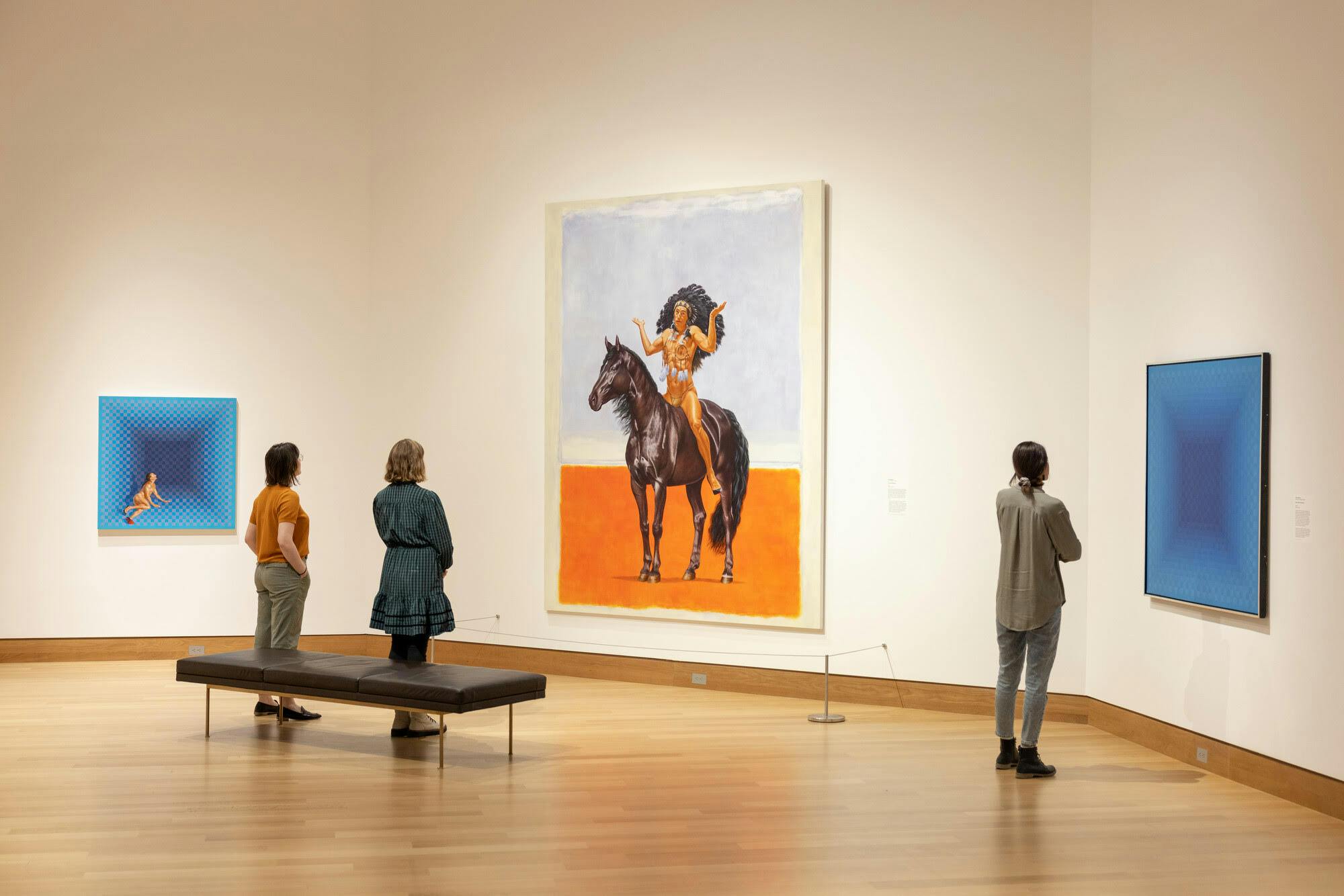On April 19 at the Hood Museum of Art, Jami Powell, Curator of Indigenous Art, and Michael Hartman, Jonathan Little Cohen Associate Curator of American Art, led a special tour titled “Painting History.” The tour touches upon the Hood’s theme for this year pertaining to art’s role in the construction of history through the exhibitions “Historical Imaginary” and “Kent Monkman: The Great Mystery.”
Hartman elaborated on the connection between art and history.
“Artworks here are really questioning how art has shaped and continues to shape our perception of the past,” Hartman said. “Our goal with that is the hope that by being more transparent with the past and the roles that artworks have played that maybe we can build towards a more equitable future.”
The tour began with the “Historical Imaginary” exhibition, located in the entrance gallery to the museum. This exhibit consists of works including Emanuel Leutze’s 1851 “Incomplete Study of Washington Crossing the Delaware” alongside “George Washington (On A Stick),” created by Valerie Hegarty, and a sketch of Washington by José Clemente Orozco. All addressing Washington as a subject, these three artworks were produced at different times and use varying approaches — embodying the unique interpretations that can be produced about the same historical subject. For example, “George Washington (On A Stick)” has a melted black material obscuring Washington’s face, while Orozco’s sketch is a straightforward rendering.
This exhibition additionally pairs these depictions of George Washington with other pieces from the Hood Museum’s collection, including a Wampum belt recently gifted to the College by the Mohegan nation when Samson Occom’s papers were repatriated. This belt is made of purple and white beads, symbolizing unity after conflict through its portrayal of figures hand-in-hand. Hartman explained the value of the Wampum belt, as it creates a more comprehensive understanding of local history.
“The belt within the context of this exhibition is really representing how reckoning and telling a more complete history locally allows us to build a better future together,” Hartman said.
Directly above the “Historical Imaginary” exhibition on the second floor of the museum, Powell guides the tour to Cree artist Kent Monkman’s painting “The Great Mystery.” This painting draws inspiration from Mark Rothko’s notoriously bold, color-blocked paintings and Cyrus Dallin’s 1908 statue of a Native American man with his arms spread wide on horseback, called “Appeal to the Great Spirit.” Influenced by these two iconic artworks, Monkman created “The Great Mystery,” commissioned for the Hood’s permanent collection. In the painting, Monkman depicts his alter ego — Miss Chief Eagle Testikle — on horseback wearing a Native American headdress and dream catchers on a backdrop of Rothko’s painting “Lilac and Orange Over Ivory.” Monkman utilizes Miss Chief Eagle Testikle as a character that challenges the gender binary; the figure is male-presenting but wears more “feminine” clothing. Through “The Great Mystery,” Monkman hopes to convey to audiences that uncertainty is welcome; he embraces ambiguities rather than binaries.
Powell discussed how the inclusion of Indigenous perspectives connects back to the Hood’s theme for this year.
“When we use this theme of art in the construction of history, we can think about whose voices are included, whose voices are not, who’s allowed to tell their own history,” Powell said. “This Cree artist reimagines a depiction of Indigenous peoples from the Cyrus Dallin sculpture over 100 years later in a different context.”
In addition to Kent Monkman’s “The Great Mystery,” this exhibition includes works from other artists such as Rothko and Indigenous artist T.C. Cannon, bringing modern painters into the conversation of American art history. Powell also emphasized the need for representation and diversity in artistic spaces in order to foster important dialogue.
“Enabling Native students and also queer or trans students to see this really powerful representation … is something that is really impactful for me and drives my work,” Powell said. “But [it is] also something that I hope we can build on in the future, as we make the collection here at the Hood Museum reflect the diversity and multiplicity of our growing student population.”
The Hood Museum’s special tour “Painting History” drew audience members from Dartmouth’s student population, visiting alumni and members of the local community. One attendee, Sebastian Fernandez ’24 reflected on the experience, appreciating the role of the curators.
“It’s always really refreshing to be able to hear directly from the curators,” Fernandez said. “It’s one thing to be in the museum and read the labels and come up with your own interpretations from the didactics, but it’s really cool to hear the thought process and intellectual connections made by the curators between the artwork within their own exhibits and also between each other’s [exhibits].”
Having curators themselves speak on their work provides an opportunity for people to learn more about the processes behind constructing exhibitions and connect more with the Hood’s mission, which hopes to “center art and people in teaching and learning through inclusive and robust academic, cultural and civic engagements with art and its histories.”




